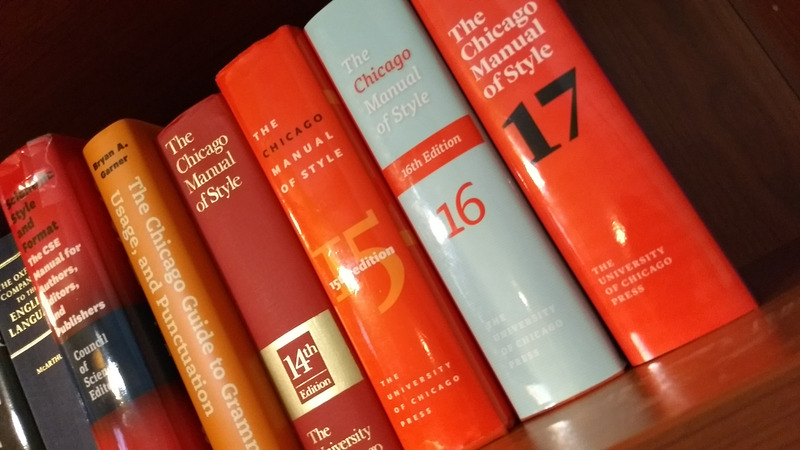You’ve received your manuscript back from your editor. They’ve made a lot of great catches and asked some insightful questions. But what’s this other file they’ve sent, this “style sheet”? And what do you do with it?
A style sheet is a record of editorial decisions and other information related to your manuscript. It’s an important tool for editors and proofreaders, and it’s a valuable resource for writers and publishers. Let’s look at what’s in it and what you do with it.
Editorial Decisions
The first big category of information are the editorial decisions. As your editor works on your document, they’ll note specific changes they’ve made that apply throughout the document. That can include alternative spellings of words (dialog instead of dialogue), the capitalization of section titles (headline or sentence style), and when numerals are used for numbers rather than words (zero through nine, 10 and up).
Your editor will also note special terms used in your manuscript, such as terms of art (micro-frontend), jargon (stratification), and unique terms in your manuscript (New Riding Identity).
They’ll also record abbreviations used in your document (SVP, ROI). This helps them track which abbreviations have been introduced already, which aren’t spelled out, and when an abbreviation is used for more than one term (which they’ll correct).
Proper nouns are another big category in your style sheet. Any proper noun entered should first be fact-checked so everyone using the file can trust the information given.
Your editor may also include helpful notes for any of the terms listed, such as:
- Johnson & Johnson (ampersand is part of the official name)
- Senator Elizabeth Warren (D-MA)
Writer and Publisher Preferences
If you share any writing or word preferences with your editor, they’ll note them on the style sheet to ensure they correct for them. For example, I have one client that doesn’t want us to use the word via in text, so we note that. Another client wants all job titles capped in text: Calvin Johnson, Director of Widgets. We note that, too.
World-Building Details
This is a concern mostly for fiction and other kinds of storytelling. Especially when you’re making up characters and events, you want the details to be consistent and make sense. Editors will watch for, and make notes on, things like:
- Character names and significant details. Details can include eye and hair color, a habit, an injury—whatever might seem significant to the story. They’ll also record relationships to help you maintain the family tree.
- Setting details. These will vary, depending on the detail you put into the story. It might be the layout and furniture of a room or the layout of streets in a city center or features of the planet you’ve created. Is it realistic that your character can walk to a specific destination? Can humans breathe the atmosphere? If not, your editor will watch that characters put on breathing apparatus before going outside.
- Timeline. This could be a very rough sketch of the order of the actions or something more detailed, such as a calendar layout. Again, it depends on the details you provide. The more you provide, the more your editor will want to ensure everything lines up. Though we may like it, we can’t have two Saturdays in a week—at least, not in realistic fiction!
Some fiction editors create separate style sheets for characters, settings, and timelines. But whether it’s one style sheet or several, your editor will track details to help ensure a stronger story.
Get writing advice straight in your inbox.
Sign up for Right Touch Editing’s emails!
Is a Style Sheet the Same as a Style Guide?
A style sheet is generally for one project, while a style guide (or manual) is for all of a publisher’s or company’s projects. It covers spelling, capitalization, numbers, punctuation, and more, depending on the type of publications the guide is for.
The Chicago Manual of Style, the official style guide for the University of Chicago Press, is widely used in book publishing. It features sections particular to books and journals, such as rights and permissions, illustrations and tables, mathematical elements, and citations.
AP Stylebook is the guide for the Associated Press and is used mostly by media outlets and related companies, such as PR agencies. In addition to writing style guidance, it offers guidelines for different types of journalists, such as broadcasters, data journalists, and food and fashion writers, as well as information on media law.
Companies that publish a lot of reports and other public-facing publications may also have a style guide. It too will provide writing style guidance and will likely cover branding rules, such as which fonts and colors to use and how to display the logo. Sometimes referred to as a communications guide, this guide helps a company in the same way it does a traditional publisher: promoting consistency and good writing across all of the business’s publications.
Your editor will ask if you’re following a particular style guide. This gives them a basis for making editorial decisions on a particular manuscript. If you don’t have one or aren’t sure, your editor may advise a style guide that best fits your project. They’ll still create a style sheet for the project because there will still be decisions to be made.
While the tendency is one per project, at Right Touch Editing we keep a “rolling” style sheet for some of our clients. Short projects, such as press releases and blog posts, are often too short for their own style sheets. But when there are dozens over time, having a record of past decisions can help us maintain consistency across documents, especially if the client doesn’t have their own style guide. Our file then becomes a de facto style guide for the client. Some clients have even had us write style guides for them based on our style sheet.
What Do I Do with a Style Sheet?
Since it mainly serves as a record, so you’re not required to do much with it. If you have a question on why an edit was made in the manuscript, see if it’s listed in the style sheet. It won’t answer every question, but it’s a place to start.
Pass the style sheet along to your designer and proofreader so they can refer to it for their own work. The designer will note things like which categories of words were italicized, which can guide them on what should remain italicized (e.g., words used as words) and which can be styled another way (e.g., words that are emphasized).
Your proofreader will follow the style sheet closely to ensure the final text is correct. They’ll refer to the terms section to ensure everything is spelled correctly. They’ll note how titles were handled, as well as numbers and punctuation. The style sheet is a critical tool for your proofreader.
Finally, should you decide to write another book or publish articles regularly, your style sheet can help you create a more consistent style across your writing, increasing the professionalism of your work. For books in a series, it will help keep details straight across the entire series.
Your Style Sheet Reflects Your Writing Style
The style sheet isn’t the sum of your manuscript but a particular view of it. Perhaps one of your characters has an interesting fact about them you can expand on in their next story to make them more real. Maybe it’s a preference for abbreviations or jargon. Or something else you weren’t aware of. These aren’t bad things; they just are. The more you understand about your writing style, the more you can use it intentionally and improve your writing.
Next time you work with an editor, ask to see your style sheet. You’ll learn a lot about your manuscript and may learn something to apply to your next writing project.




thank you. Very useful